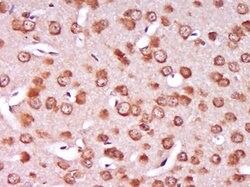Promotional price valid on web orders only. Your contract pricing may differ. Interested in signing up for a dedicated account number?
Learn More
Learn More
SLC27A1 Rabbit anti-Human, Polyclonal, Bioss


Rabbit Polyclonal Antibody
Supplier: Bioss BS10556R

Description
SLC27A1 is a protein coding gene. Mediates the ATP-dependent import of long-chain fatty acids (LCFA) into the cell by mediating their translocation at the plasma membrane. Has also an acyl-CoA ligase activity for long-chain and very-long-chain fatty acids. May act directly as a bona fide transporter, or alternatively, in a cytoplasmic or membrane-associated multimeric protein complex to trap and draw fatty acids towards accumulation. Plays a pivotal role in regulating available LCFA substrates from exogenous sources in tissues undergoing high levels of beta-oxidation or triglyceride synthesis. May be involved in regulation of cholesterol metabolism.Specifications
| SLC27A1 | |
| Polyclonal | |
| Unconjugated | |
| SLC27A1 | |
| ACSVL5; ACSVL5FATP-1; EC 6.2.1; Fatp; Fatp1; FATP-1; Fatty acid transport protein; fatty acid transport protein 1; FLJ00336; Long-chain fatty acid transport protein 1; MGC71751; Slc27a1; solute carrier family 27 (fatty acid transporter), member 1; Solute carrier family 27 member 1; solute carrier family 27, member 1 | |
| Rabbit | |
| Protein A | |
| RUO | |
| 376497 | |
| -20°C | |
| Liquid |
| Immunofluorescence, Immunohistochemistry (Paraffin) | |
| 1 μg/mL | |
| PBS with 1% BSA, 50% glycerol and 0.09% sodium azide; pH | |
| Q6PCB7 | |
| SLC27A1 | |
| KLH conjugated synthetic peptide derived from human SLC27A1. | |
| 100 μL | |
| Primary | |
| Human | |
| Antibody | |
| IgG |
Product Content Correction
The Fisher Scientific Encompass Program offers items which are not part of our distribution portfolio. These products typically do not have pictures or detailed descriptions. However, we are committed to improving your shopping experience. Please use the form below to provide feedback related to the content on this product.
Product Title
Spot an opportunity for improvement?Share a Content Correction
